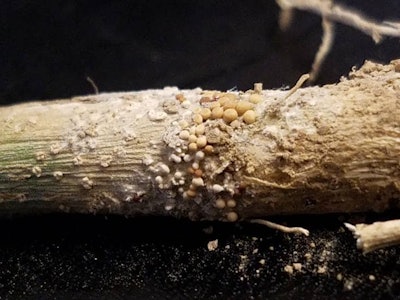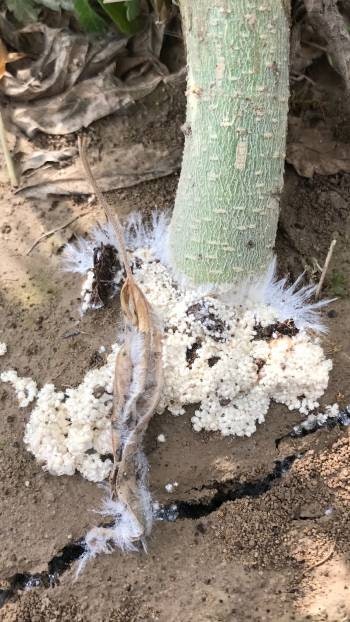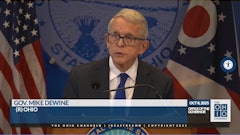
Each summer, farmers working in hot and humid regions may find their crops exposed to a fungus called Sclerotium rolfsii. They may notice lesions on their plants’ stems, chlorosis (yellowing leaves), root decay, crown rot and even an abrupt die-off of the entire crop.
Colloquially, the disease caused by this soil-borne pathogen is known as Southern blight.
 southern blight
southern blight“When we say ‘blight,’ blight really means, ‘subject to sudden death,’” says Nicole Gauthier, an extension specialist in plant pathology with the University of Kentucky. “It’s when something seems to be OK today and dead tomorrow. When things blight, usually the leaves will remain intact.”
Each summer, reports of Southern blight surface in university extension reports from Louisiana to southern Ohio and beyond. It’s a ubiquitous pathogen, one that can be found almost anywhere there’s soil. With a wide host range, Sclerotium rolfsii has no shortage of opportunities to flourish. Hemp is certainly not an exception.
With midsummer’s rain-soaked stretches across the Midwest and the South, 2021 is shaping up to be similar to recent years. Though, generally speaking, states are seeing fewer acres of hemp planted this year, the crop is still very much subject to Southern blight. “A hot rainy summer is dead-on for what this pathogen needs to really proliferate,” Gauthier says.
All fungi need a significant amount of water to complete their life cycles—and so does hemp. This sets up a problematic showdown in the field.
Gauthier says that one of the first things to consider with this pathogen is the history of the land. She sees Southern blight running rampant in crops that follow unmanaged pasture or uncultivated terrain. Over the last several years, as more farmers have gotten into the hemp space (and, in many cases, expanded their fields to accommodate this move), that’s a common issue.
“Surprisingly, that seemed to be a hot spot for Southern blight,” Gauthier says. “That basically tells that tale for us, that the pathogen was there all along.”
Over time, buildup of this pathogen is very likely. Imagine the use a farmer might get out of his or her tractor—or even muddy shoes. Fungus in the soil can easily be moved around very quickly once farmland is activated with, say, a crop of hemp plants.
“Southern blight already was so very difficult to manage, but now we've got a crop that doesn't have the approved pesticides,” Gauthier says.
Prevention, then, is not so easy.
“When we see diseased plants, we need to remove them immediately,” she says. “If not, then that's when we have that spoilation and the production of those scleroses—those survival structures in that soil. The more we have the buildup of that inoculum in the soils, the higher risk next year's crop is going to be—but also the higher risk it is that you're going to move it around with your tractors, your equipment, your shoes, your tires, that type of thing.”
It’s a double-edged sword.
Nonetheless, rogueing those affected plants as soon as symptoms emerge is a critical cultural practice. Southern blight can spread fast.
So, how do you identify this problem?
The pathogen attacks the crown of hemp plants, girdling the organism and stopping any uptake of water and nutrients into the upper canopy. This produces the “sudden death” effect. Wilting is the first sign of this problem, so be sure to keep your eyes attuned to the tops of your plants.
Because this is fairly weather-dependent, think about the water needs of your hemp crop during hot summers. Dry spells increase the pressure on those plants, which, as Southern blight settles in, can prompt a much faster die-off.
On the other hand, certain conditions may also slow its effects.
“This year in Kentucky, it's very rainy,” Gauthier says. “So, the demand on that plant is less. You might have a slower die-back. It depends on the intensity of that girdling at the crown. It may occur slowly.”
As late July slips into early August, now is the time for farmers to monitor their crops even more closely for this particular pathogen.
























